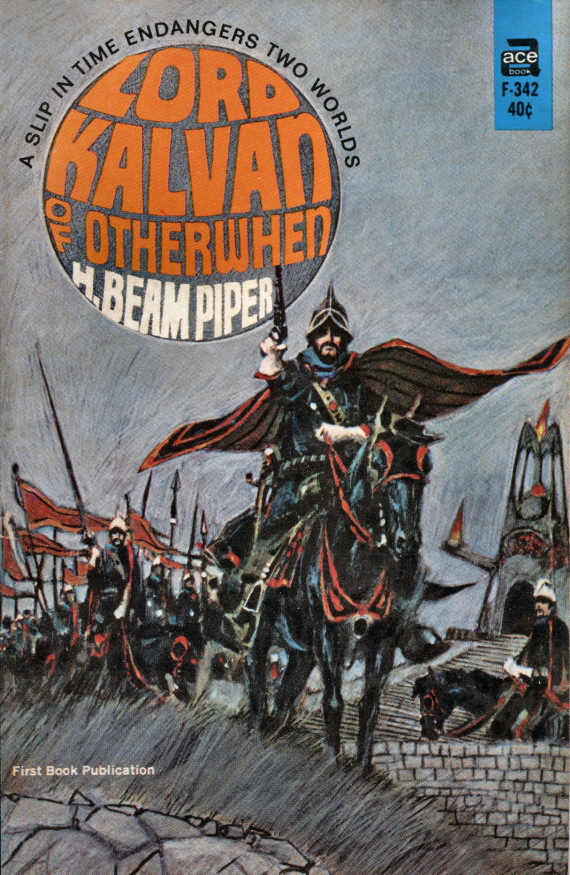
Seems like in every decade of my past, I had a couple of “must-read” authors; people whose writing you absolutely can’t afford to miss (not counting the Big Names of the time, like Robert A. Heinlein, Arthur C. Clarke, Isaac Asimov).
Back in the sixties and seventies, two of those writers for me were H(enry) Beam Piper and Keith Laumer. Now, both of those writers were quite popular, but I don’t think they ever achieved “cult” status. Some of their writings, while way up there in the popularity charts, never quite hit it for me, which kind of sounds contradictory, but everything else they wrote just fit the bill. (In case you’re wondering, the Piper stuff that left me rather cold—while still well written—were the “Little Fuzzy” stories; the Laumer stuff that wasn’t my cup o’ tea were the Retief tales. Everything else by these two I doted on. Seriously. And, oddly enough, the Little Fuzzy covers by Michael Whelan are my least-liked Whelans, and I’ve been a giant Whelan fan ever since I first saw his original artwork at Westercon 28 in 1975!)

One of my favourite types of story is the modern-day person adrift in another time or, in the case of “Lord Kalvan,” another dimension.
Now, Piper didn’t invent the transdimensional-travel sort of story, but he did it so well. (Offhand—without worrying about who came first, I can think of Murray Leinster’s Sidewise in Time, Ward Moore’s Bring the Jubilee and a bunch of more modern stories as well as Eric Flint’s Ring of Fire series.) Besides Lord Kalvan (which is only peripherally a Paratime Police story), Piper also wrote other tales of the Paratime Police; in these tales, dimensional travel was discovered in only one universe and was their well-kept secret.
In Lord Kalvan of Otherwhen, Pennsylvania State Trooper Corporal Calvin Morrison got caught in the fields of two “dimensional conveyor heads” that overlapped, and was sent to a dimension in which the whole history of the world was changed, although the time was the same. (In that “paratime,” the Aryan-Transpacific, some of the Aryan peoples that had moved south and west through Asia in our timeline moved east instead, bringing horses and metalworking to North America, and wiping out the indigenous tribes they found there.)
This was the paratimeline Calvin wound up on. He was lucky; most of the people who got inadvertently caught in these fields were unable to adapt, and went insane and/or were killed—by the Paratime Police—to keep them from interfering on the paratimelines they found themselves in. Morrison, who had been participating in a raid on an armed suspect, was quick enough on the draw to defend himself from the Paratime agent who would have otherwise killed him; likewise, he was quick enough mentally to discern (within his limits) what had happened to him and to adjust to the situation, allying himself with the right people and gaining an “in” with the local power structure.
How Calvin became “Lord Kalvan” and what he did with his life thereafter—for he was never to return to his “home” paratimeline—forms the crux of what was, for me, an extremely enjoyable novel. Calvin/Kalvan is the prototypical “competent person” (akin to a Heinlein hero, maybe?) that I enjoy reading about.

Piper’s Space Viking, while not tied to the Paratime Police stories, was likewise an enjoyable action/adventure—okay, let’s call it what it is: space opera! Set in a far-flung future when the Terran Empire has long since fallen and many planets have returned to a pre-technological stage of existence, it details the adventures of one set of people who are part of a loose-knit cabal of planets who haven’t lost their technology, but are tied together by traders and “Space Vikings,” those who raid the less well-defended planets to plunder what they can and trade for what they need. (Aiding in all this is a not-very-well defined “hyperspace,” in which one can travel a light-year in an hour of shiptime.)
While I didn’t like it as well as Lord Kalvan in this week’s reading binge, I did like the way these “Viking” raids were shown to unify various worlds in trading, and also to uplift more primitive cultures to ones that could participate in interstellar trade and culture. I do, however, decry the fact that a lot of death is glossed over—including the use of nuclear weapons and “planetbusters”; as if this is simply a cost of doing business.
But who knows, maybe that’s just me. One of the things I found amusing in both books is that Piper, a pipe-smoker himself (judging from photos I found online) has practically everyone smoking pipes or cigars—but rarely cigarettes—in these futures. Also, in the various Piper books I read this weekend, there are only male protagonists; especially in the Space Viking book, women are relegated to secondary roles only. My, how times change. Leaving all that aside, however—if you can—these books are fast-paced and well written.

And we mustn’t forget what I believe is Piper’s most-liked fiction: the Little Fuzzy. I haven’t read one of these in years, so I won’t even try to describe them; I won’t cheat and pirate a description from online. All I remember is that I found them kinda “cutesy”—especially Whelan’s portrayal of them (Figure 4). There are only so many reading days in a week, and I do have other things to do as well as this column; possibly I’ll get back to them when I come back to Piper in a future column.
I also read Piper’s Four-Day Planet, about a planet called “Fenris” (after a mythological wolf), whose year is four thousand hours long, and whose days are a thousand. Fenris is a world of extremes, and inhospitable to humankind; however, there is a planetary population of a few thousand humans. The protagonist is a 17-year-old (male) reporter for the local news outlet (owned by his father). This probably qualifies it as a YA by today’s standards—except for the aforementioned smoking—and I found it quite enjoyable.
So here’s the deal, folks—nearly all of H. Beam Piper’s writing has fallen into the public domain! Most of his work is available from Project Gutenberg or from manybooks.net. If you’ve never read any of this talented writer’s stuff, here’s your chance—just click on either link!

Another author I never got the chance to meet or correspond with (I’m a terrible correspondent, for one thing) was Keith Laumer, though I adored his writing for the most part. He had a number of popular series, from his tales of interstellar diplomacy (or lack thereof) featuring Retief—which were informed by and spawned by Laumer’s own experiences in diplomatic service, I am told; through his various non-linked books featuring people who inadvertently become empowered and in some cases superhuman; through his tales of the gigantic artificial-intelligenced monstrosities (larger than some buildings) that are the descendents of modern tanks, the Bolos.
Oh, and he also had a couple of series of alternate-world tales; one featuring The Imperium (Worlds of the Imperium) and the other the hapless dreamer Lafayette O’Leary. When I’m looking for a fast retro read featuring time travel, alternate world travel, incompetent diplomats, people learning to be “all that they can be,” or giant, intelligent war machines that are more honourable than most humans, I pick up one of the many Laumers on my bookshelves and have a most pleasurable hour or two (I’m a very fast reader).

One story I read in Worlds of IF magazine in the ‘70s concerned a man who got caught in a Middle East conflict that was more than it seemed. John Bravais is sent to Tunisia as a war observer like many others; war in this time is regulated by the U.N. and run according to certain formal rules; however, Bravais has a secret mission: to find out why casualty reports in this (and many other wars) don’t seem to match up with the “official numbers.”
Bravais finds out that there are aliens involved, and they are (see Figure 6) harvesting human brains! (The original illustration by Ed Emshwiller—from the magazine—I found in the dealers’ room at Westercon 28, and it’s the only original EMSH I own.) From there it gets complicated; Bravais gets a full-body makeover, with embedded subcutaneous mesh that makes him darned near invulnerable, plus muscle and bone implants that give him superhuman strength and endurance. Later he finds out why the aliens are harvesting brains… the hard way! It’s fast-paced action/adventure SF as only Laumer can write it. Dang! Now I have to go reread the book!

Figure 7, cover by Powers, illustrates a book about Laumer’s diplomatic alter-ego, Jaime Retief. Although the series is rife with Laumer’s sarcastic humour—especially when dealing with Retief’s putative boss, Under-Ambassador Magnan—it’s not my favourite Laumer. It is well written, and the way Retief prevents wars and solves diplomatic crises while at the same time saving Magnan’s overstuffed rear end is amusing. I do enjoy them, but not as much as the rest of Laumer’s work. (Also, in case you haven’t noticed, all of these covers except the Powers actually illustrates the book in question—the covers show the artist has read and understood the writer’s description of people and/or action.
The reason Powers’s cover doesn’t (I think) is that Powers hated science fiction; in a letter to my late friend Jon Gustafson, Powers said he thought most science fiction was crap. I found that amusing, considering the number of covers he did. And I liked his work anyway.)

I haven’t read Dinosaur Beach in a while; however, I do remember it involves a lot of the stuff I enjoy about reading Laumer. There’s a guy (written in first-person) named Ravel, who is an operative from Time Central, working out of Dinosaur Beach (so called because Nexx Central, who Ravel works for, found a small troup of allosaur-like reptiles on it when they first set it up, some 65 million years in the past) trying to forestall the Kargs, a bunch of AI robots, from messing with the timelines. (It’s all explained better in the book.) Along the way, Ravel finds a lot of “things are not what they seem”—a Laumer staple, by the way—and the writing is very fast, the action very furious. There’s a lot of time travel, willy-nilly, and Ravel and the reader are both confused a lot of the time… but Ravel, as the competent Laumer hero, soldiers on. Again, now I’m gonna have to dig out the book and read it again. I have my work cut out for me now!

And lastly, another of my favourite types of Laumer book, the Bolo book. The Bolo is an AI’d, mostly autonomous war machine, descendant of today’s tanks, and is usually about the size of a city block. In many of the Bolo stories, the Bolo in question is a veteran of a war that is years or decades in the past, decommissioned (and supposedly brain-burned) and/or lost and off the register. The protagonist of the story discovers that the Bolo is merely quiescent and somehow manages to activate it in time to fend off an alien attack or something of the sort.
They’re all to a sort of formula, and to me, at least, they’re extremely fun to read. And here’s something you might like: Project Gutenberg has nine of Laumer’s stories for free! (No Bolos, unfortunately.) The link above is direct; if you’re not already a Laumer fan, I think you might become one.
I’d love it if you’d comment on this week’s column. You can either register and comment here, or you can comment on my Facebook page, or in the several Facebook groups where I publish a link to this column. I might not agree with your comments, but they’re all welcome. Don’t feel you have to agree with me to post a comment; also, my opinion is, as always, my own, and doesn’t necessarily reflect the views of Amazing Stories or its owners, editors, publishers or other bloggers. See you next week!
Steve has been an active fan since the 1970s, when he founded the Palouse Empire Science Fiction Association and the more-or-less late MosCon in Pullman, WA and Moscow, ID, though he started reading SF/F in the early-to-mid 1950s, when he was just a sprat. He moved to Canada in 1985 and quickly became involved with Canadian cons, including ConText (’89 and ’81) and VCON. He’s published a couple of books and a number of short stories, and has collaborated with his two-time Aurora-winning wife Lynne Taylor Fahnestalk on a number of art projects. As of this writing he’s the proofreader for R. Graeme Cameron’s Polar Borealis and Polar Starlight publications. He’s been writing for Amazing Stories off and on since the early 1980s. His column can be found on Amazing Stories most Fridays.










Yeah, Joe–but I’m not sure the Lafayette O’Leary series, which is humorous fantasy, in my opinion, qualifies as a time-line-travel series. Just my opinion!
But Keith Laumer also wrote a time-line travel series! The first one, Worlds of the Imperium (1962), set the stage, with an American diplomat being abducted by the Imperium to take part in a mission to save them from being nuked. There are three more, The Other Side of Time (1965), Assignment in Nowhere (1968), and Zone Yellow (1990). The first three are published in an edited edition as Imperium (2005); since Zone Yellow is basically Assignment in Nowhere with a different set of villains, that’s probably just as well. But interestingly enough, Laumer also wrote a prequel to Worlds of the Imperium, Embassy (1965) with the protagonist of WotI having a completely mundane experience — except that it ends with him being posted to where WotI begins!
Laumer also wrote the Lafayette O’Leary series, a more humorous version of the theme.
Laumer had been in the diplomatic service, which explains both Embassy and the Retief series.
EMBASSY was filmed in 1972 with Richard Roundtree and Chuck Connors. Sort of ironic that out of all Laumer’s books, the only one Hollywood was interested in was his sole non-SF title. Might be differrent if he was writing today.
IMDB states that the novel it was based on was by Stephen Coulter.
https://www.imdb.com/title/tt0068538/?ref_=nm_flmg_act_145
IMDB states that the novel that the movie EMBASSY was based on was by Stephen Coulter.
https://www.imdb.com/title/tt0068538/?ref_=nm_flmg_act_145
Just goes to show you shouldn’t rely on memory for movies you haven’t seen in almost 50 years. Actually I didn’t like EMBASSY that much so I’m sort of glad it wasn’t based on the Keith Laumer novel.
You forgot 1969’s THE MONITORS https://www.imdb.com/title/tt0064684/?ref_=fn_al_tt_3